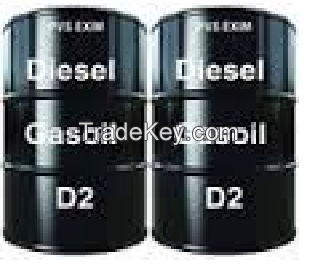Product Description
D2 diesel fuel is the broad category for the second distillate of
crude oil. Ultra-low sulfur
grades of D2, such as GOST *****2, reduce sulfur content to a
maximum of 0.*2 percent and
reduce sulfur pollution emissions.Diesel fuel is often used in
diesel engines. Diesel engines, also
called compression ignition engines, rely on the temperature
increase of compression, rather than
on spark plugs, to achieve reliable ignition timing and combustion
efficiency.
As a result of their inherently higher compression ratio for a
given power output, diesel
engines are more fuel efficient than spark ignition engines.
However, compared with spark
ignition automotive engines, diesel engines weigh more, generate
more vibration and produce
greater particulate or soot emissions. Diesel engines can also
produce a particularly carcinogenic
type of hydrocarbon pollutant known as polycyclic aromatic
hydrocarbons (PAHs), which are
generated during the diesel combustion process.
The cetane index is a measure of the auto ignition quality of a
diesel fuel, with higher
numbers meaning that the engine is easier to start in cold weather.
The principal difference
between GASOIL and D2 is the content of sulphur. Just *0 years ago,
the US EPA introduced a
limit of 4% sulphur in the GASOIL, whereas Europe and the rest of
the world followed later. As
in most other cases, when you first have to remove the sulphur, it
was soon discovered ways of
doing this more efficient. Then it was discovered that the sulphur,
as sulphuric acid, could be
traded with a good profit - which now is the motivator for
extracting as much as possible.
So "Low sulphur Gasoil" is no longer 4 percent - but below 0.2
percent. Then we have a new,
"Ultra Low Sulphur" at 0.*2% at the most, and the limit here is (a)
that mass spectographs
requires extensive calibration to measure below ***0ppm, and (b)
sulphur has a way to form
clogs - the molecules binds to free hydrogen molecules and form a
cluster of molecules that will
break if "cracked" by the refinery, but as explained above, D2 is a
distillate and has not been
"cracked".
ISO has a standard for D2 that most of oil companies use as their
reference. In the U.S. it
is ANSI that has defined the US national standard for D2, according
to proposals from the
ASTM, API and EPA.In Europe there are similar national variants,
e.g. in Germany set by DIN,
and in Russia by GOST.
The GOST variant for D2/Gasoil is GOST *****2 and specifies now a
sulphur content of
0.*2 MAX which is according to the ISO standard. However, the ANSI
standard will call this
"Ultra Low Sulphur", and retain 0.2% (***0ppm) as the "Low sulphur.
The reduction of
sulphur in the Gasoil used for heating has contributed to less
pollution in many cities.
Automotive diesel has national variants - but the usual variants
traded are EN**0 and
EN**0 which are specified by ISO in Paris. These qualities may be
sold in the U.S., and be
compliant with EPA regulations in the U.S. Automotive diesel is now
tested in planes with great
success, where you get greater mileage per weight unit of fuel - as
much as *0% increase. In
these days, when no stone remains unturned to reduce emissions, one
outcome may be that
planes will fly on Gasoil and not kerosene. The problem is
condensate / ice particles and wax
that may cause the jet engine (which is a turbine) to be completely
destroyed. A preliminary
solution is to heat the gasoil before injection, and pass it
through an electrostatic filter.
| Country: |
Malaysia |
| Model No: |
-
|
| FOB Price: |
(Negotiable)
Get Latest Price
|
| Place of Origin: |
- |
| Price for Minimum Order: |
- |
| Minimum Order Quantity: |
50000 Metric Ton |
| Packaging Detail: |
- |
| Delivery Time: |
- |
| Supplying Ability: |
- |
| Payment Type: |
- |
| Product Group : |
- |

